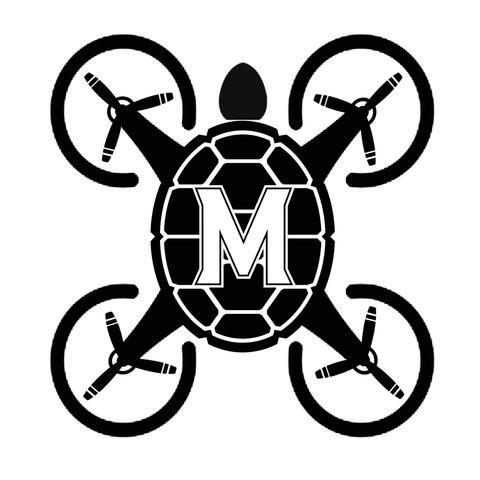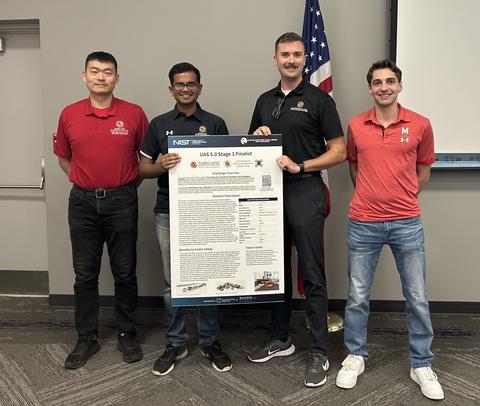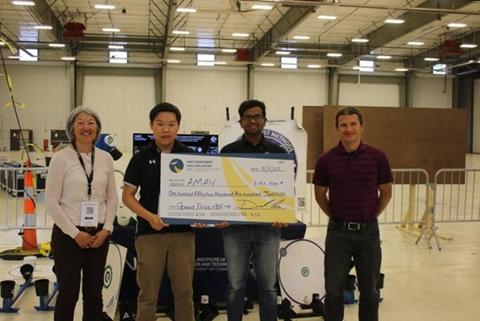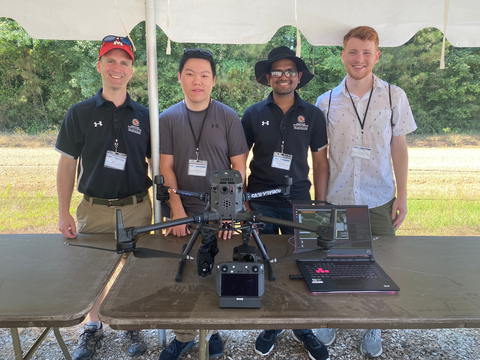AMAV (UMD)

Team name
University of Maryland (UMD) Autonomous Micro Aerial Vehicle (AMAV) Team
Awards
- UAS 5.0: First Responder UAS 3D Mapping Challenge
- Stage 3:
- 3rd Place: $30,000
- Best-in-Class – Map Data Acquisition Speed: $10,000
- Best-in-Class – Blue or Green UAS Capable: $5,000 (tied)
- Best-in-Class – Bill of Materials Total Cost: $10,000
- Stage 4 – Winner: $30,000
- Total 5.0 Prizes: $120,000
- Stage 3:
- UAS 4.0: First Responder UAS Indoor Challenge
- Grand Prize: $100,000
- Best-in-Class – Ease of Operation: $7,500 (tied)
- Best-in-Class – Flyability: $15,000
- Best-in-Class – Additional Preferred Capabilities: $15,000
- Best-in-Class – First Responders’ Choice: $15,000
- Total 4.0 Prizes: $172,500
- UAS 3.1: First Responder UAS Triple Challenge: FastFind
- 1st Place: $45,000
- First Responder’s Choice Award: $5,000
- Total 3.1 Prizes: $60,000
UAS 5.0: 3D mapping solution summary
The Intrigue Unmanned Aerial System (UAS) stood at the forefront of aerial technology, seamlessly merging an advanced aerial platform with a state-of-the-art ground control system. This dynamic duo boasted unparalleled capabilities, including real-time 3D mapping, GPS-denied navigation, and automatic detection of humans and hazards. Powered by a custom-built multispectral visual-inertial sensor system, the aerial platform meticulously captured its surroundings, crafting intricate textured mesh maps in real-time on the ground control system. Thanks to onboard cameras and cutting-edge edge computing, Intrigue operated autonomously with precision in challenging indoor environments, requiring only minimal operator guidance. A remote-controlled gimbal, offering a full 180° range of motion, ensured exhaustive mapping coverage from nearly every angle and lighting condition imaginable. Facilitating seamless communication, multiple high-penetration wireless radio links ensured uninterrupted transmission of crucial data to the Ground Control Station. From FPV camera feed to telemetry, mapping data, and tagged human locations, the flow of information remained steadfast and reliable. With real-time rendering capabilities on the Ground Station computer, operators were granted access to vivid, detailed maps with lightning-fast update rates and minimal latency. Furthermore, the system's impressive post-processing speed, measured in mere minutes, provided operators with texturally enriched, highly detailed maps on demand, revolutionizing response strategies during emergencies. In the ever-evolving landscape of public safety, the Intrigue UAS set the gold standard, empowering agencies to navigate and respond to indoor challenges with unparalleled efficiency and effectiveness.
UAS 4.0: Indoor solution summary
Team AMAV’s (UMD) Gambit was a low-cost, easy-to-fly drone specifically tailored to operate indoors, while providing full light, low light, and thermal imaging. The drone design, fabrication, assembly, and testing were performed by University of Maryland students. Due to advanced onboard sensor processing, Gambit was capable of maintaining the desired position and orientation without GPS making it possible to operate predictably in challenging indoor environments with minimal training. Thermal, HD, and night-vision cameras were mounted on a remote-controlled gimbal with a 180° range of motion, which enabled the drone to precisely maneuver in constrained environments and positively identify objects of interest in any lighting condition.
UAS 3.1: FastFind solution summary
Team AMAV’s (UMD) system was based on the DJI Matrice 300 drone, a popular choice for first responders. The M300 drone was equipped with a Zenmuse H20 RGB camera and a FLIR Vue TZ20 thermal camera to enable person detection in an occluded environment like a forest. To facilitate the use of the system by first responders and to enhance the probability of detecting missing people from aerial video, custom-built software was developed for mission planning and real-time image processing. AMAV’s first responder software included a machine-learning algorithm trained to process the live video stream from the drone and provide a visual indicator to the operator if a person is detected. The AMAV software ran on a laptop connected to the DJI Smart controller via an HDMI cable. The modularity of the AMAV software ensured that it could be adapted to support most UAS platforms preferred by first responders.
Team description and biographies
The University of Maryland’s Autonomous Micro Aerial Vehicle Team is a student team that designs, builds, and flies multirotors to compete in national and international competitions. The UMD AMAV team is sponsored by the Maryland Robotics Center, the UMD Department of Aerospace Engineering, and the UMD A. James Clark School of Engineering.
- Derek A. Paley (faculty advisor) is Director of the Maryland Robotics Center and Willis H. Young Jr. Professor of Aerospace Engineering Education in the Department of Aerospace Engineering and the Institute for Systems Research at the University of Maryland.
- Josh Gaus (co-advisor; UAS 4.0 only) is a UAS Test Engineer at the UMD UAS Research and Operations Center.
- Animesh K. Shastry is the team leader and received his Ph.D. from the the Department of Aerospace Engineering at the University of Maryland in 2024.
- Qingwen Wei received his B.S. from the Department of Aerospace Engineering at the University of Maryland in 2023 and is a certified Part 107 pilot.
- Wei “Sway” Cui (team member in UAS 3.1 and 5.0 only) received his Ph.D. from the Department of Aerospace Engineering at the University of Maryland in 2024. Prior to his current role, he worked as a software engineer in Los Angeles AFB and Wright-Patterson AFB.
- Grant Williams (team member in UAS 5.0 only) is the lead UAS Pilot at the UMD UAS Research and Operations Center (UROC).
- Srijal Poojari (team member in UAS 5.0 only) is a Ph.D. student in the Department of Electrical and Computer Engineering at the University of Maryland.
- Sydrak Abdi (team member in UAS 5.0 only) received his Ph.D. from the Department of Aerospace Engineering at the University of Maryland in 2024.
Ahmed Ashry (team member in UAS 5.0 only) received his M.S. from the Department of Aerospace Engineering at the University of Maryland in 2024.
- Jacob Safeer (team member in UAS 5.0 only) is an undergraduate student from the Department of Aerospace Engineering at the University of Maryland and was the team lead for UAS 5.0 stage 4.2.
- Alec Luterman (team member in UAS 5.0 only) is an undergraduate in the Department of Computer Science with a double major in Mathematics at the University of Maryland.
- Vijay Ved (team member in UAS 5.0 only) is an undergraduate in the Department of Computer Science at the University of Maryland.
- Henry Segal (team member in UAS 4.0 only) is a freshman in the Department of Computer Science with a double major in Mathematics and a minor in Robotics and Autonomous Systems at the University of Maryland.
- Jeffin Kachappilly (team member in UAS 4.0 only) is a 2nd-year student in the Master of Engineering in Robotics program at the University of Maryland.
- Dhruv Srinivasan (team member in UAS 3.1 only) is a B.S. student in the Department of Mechanical Engineering at the University of Maryland.
- Thomas Brosh (team member in UAS 3.1 only) received the B.S. degree in Aerospace Engineering from the University of Maryland in 2022, along with a minor in Computer Engineering. He is now employed at Northrop Grumman.
- Paul Zaidins (team member in UAS 3.1 only) is an M.S. student in the Department of Computer Science at the University of Maryland. He previously received a B.S. degree in Aerospace Engineering from the University of Texas and a B.S. degree in Computer Science from the University of Maryland.




